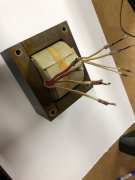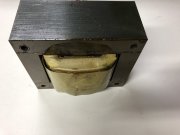In tearing down a recent PL700B for rebuild, I took notice that the transformer coil to lamination stack was loose and I could physically move the coil on the stack a small amount (~1/32") back and forth. I don't know if it was always that way or has become that way over many years due to stress relief of the winding coils and coil form.
At any rate, this looseness can be a source of audible noise because the coil will definitely vibrate on the lamination stack unless it is securely bonded to the stack. Epoxy can be used for this if you experience a similar situation. This is not obvious because one side has the black exterior end bell on it and the other side has the die cast capacitor mounting bracket on it. The coil is inside these 2 mechanical covers. A picture is below of the naked transformer.
No matter how well the coils are bonded to the lamination stack some level of hum will be present due to magnetostriction of the lamination steel itself. It microscopically grows and shrinks in size with the alternating magnetic field producing noise. This is a property of the magnetic steel and there is little you can do about this.
For those of you who have searched for the source of your audible hum, this looseness may be part of the culprit.


At any rate, this looseness can be a source of audible noise because the coil will definitely vibrate on the lamination stack unless it is securely bonded to the stack. Epoxy can be used for this if you experience a similar situation. This is not obvious because one side has the black exterior end bell on it and the other side has the die cast capacitor mounting bracket on it. The coil is inside these 2 mechanical covers. A picture is below of the naked transformer.
No matter how well the coils are bonded to the lamination stack some level of hum will be present due to magnetostriction of the lamination steel itself. It microscopically grows and shrinks in size with the alternating magnetic field producing noise. This is a property of the magnetic steel and there is little you can do about this.
For those of you who have searched for the source of your audible hum, this looseness may be part of the culprit.


